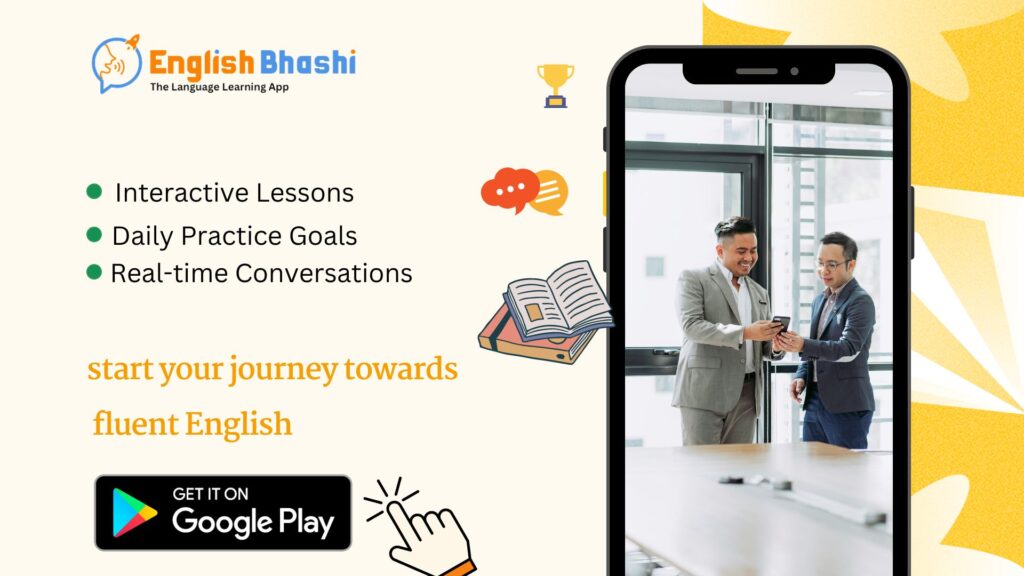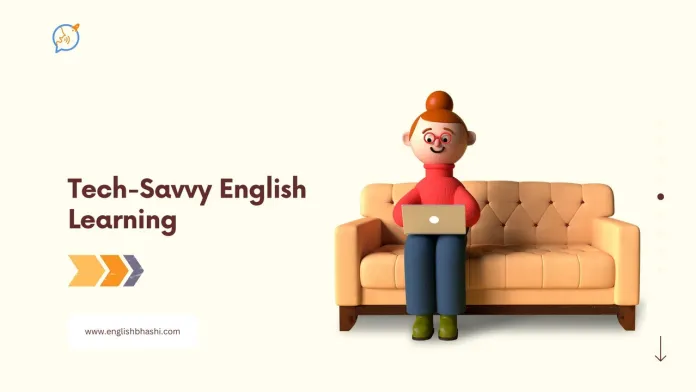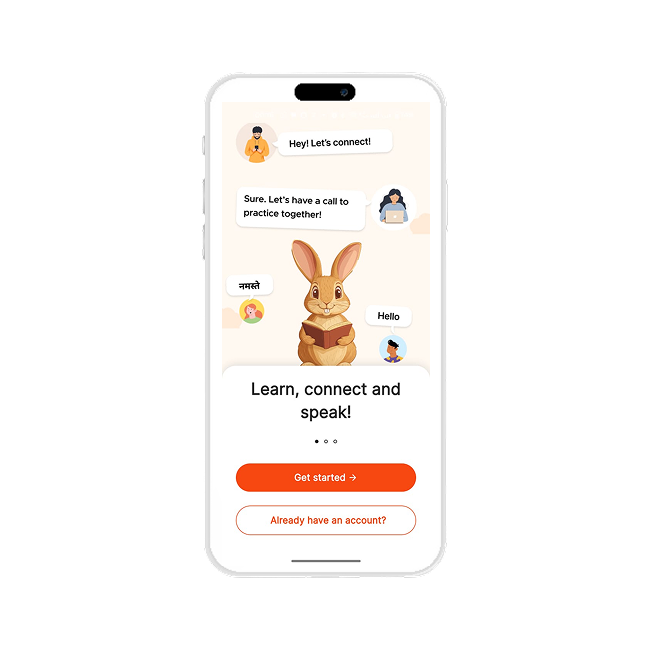Technology has revolutionized how students learn and improve English language speaking skills. With easy access to vast resources, students can now practice speaking, listening, reading, and writing at their own pace.
Apps, online courses, and interactive platforms provide engaging and personalised learning experiences, while social media and language exchange platforms offer real-world communication practice.
????️Tools like speech recognition and AI-driven feedback help learners refine their pronunciation and grammar and improve english language speaking skills.
By integrating these technological resources into their study routines, students can enhance their English proficiency more effectively and efficiently than ever.

Importance of English Proficiency
English proficiency has become increasingly important in today’s globalized world, serving as a key to unlocking various opportunities in communication, education, and personal development.

Global Communication
English has established itself as the lingua franca of the modern world, enabling people from different linguistic backgrounds to communicate effectively.
It is the dominant language in international business, diplomacy, science, and technology, making it essential for global communication.
Whether for traveling, engaging in cross-cultural exchanges, or accessing global media, English proficiency allows individuals to connect with a broader audience, breaking down language barriers and fostering mutual understanding.
Academic and Career Opportunities
Proficiency in English opens doors to a wealth of academic resources and career opportunities.
Many of the world’s top universities and research institutions use English as their primary language of instruction. As a result, students who are fluent in English have greater access to high-quality education and cutting-edge research.
Moreover, in the global job market, employers often seek candidates with strong English skills, as it enables them to engage with international clients, collaborate with global teams, and stay competitive in their fields.
Mastery of English can be a decisive factor in securing scholarships, promotions, and leadership roles, ultimately leading to greater career success.
Personal Growth
Learning English also contributes to personal growth by enhancing cognitive abilities, cultural understanding, and confidence.
Studies have shown that bilingualism or multilingualism can improve cognitive functions such as problem-solving, memory, and multitasking.
Additionally, learning English exposes individuals to diverse cultures and perspectives, broadening their worldview and fostering empathy.
As learners become more proficient, their confidence in communicating with others grows, empowering them to express their ideas and opinions more effectively.
Thus, English proficiency not only opens up external opportunities but also enriches one’s personal development.
The Role of Technology to Improve English Language Speaking Skills
The landscape to improve English language speaking skills has been transformed by technology, offering learners unprecedented access to resources and tools that cater to their individual needs.
Technology is crucial in making language learning more accessible, personalized, and integrated into education systems worldwide.
This article explores how technology has revolutionized language learning by enhancing accessibility, enabling personalized learning experiences, and facilitating the integration of digital tools into educational settings.
A. Accessibility of Learning Resources
One of the most significant contributions of technology to language learning is the increased accessibility of resources.
In the past, learning a new language often required enrolling in a formal class, purchasing expensive textbooks, or relying on limited audio materials.
Today, the landscape is vastly different, thanks to the availability of apps, websites, and platforms dedicated to language learning.
Apps like Duolingo, Babbel, and Memrise offer structured language courses that can be accessed anytime and anywhere, making it easier for learners to fit language practice into their daily routines.
???? Pro Tip: These apps often include features like gamification, where learners earn points and badges for completing lessons, making the learning process more engaging and motivating
Websites such as FluentU and LingQ provide a wealth of authentic language content, including videos, articles, and podcasts, which are tailored to different proficiency levels.
These platforms often include interactive features like quizzes and flashcards, allowing learners to reinforce their understanding of new vocabulary and grammar structures.
Additionally, language exchange platforms with native speakers around the world provide opportunities for real-time conversation practice.
This access to native speakers and authentic language use is invaluable for developing fluency and cultural understanding, which are essential components of mastering a new language.
B. Personalized Learning Experiences
Another key advantage of technology in language learning is its ability to cater to different learning styles and paces.
Traditional classroom settings often follow a one-size-fits-all approach, which may not be effective for every learner.
Technology, however, offers personalized learning experiences that can be tailored to individual needs and preferences.
AI-driven language learning apps to improve English language speaking skills
⚡ For Example, adapt to the learner’s progress by adjusting the difficulty of exercises based on their performance.
This ensures that learners are continually challenged without becoming overwhelmed, which helps maintain motivation and encourages consistent practice.
For instance, if a learner struggles with certain grammar rules, the app may provide additional exercises and explanations to reinforce their understanding.
Moreover, technology allows learners to choose the format best suits their learning style.
Visual learners can benefit from videos and infographics, while auditory learners may prefer podcasts and interactive audio lessons.
Kinesthetic learners, who learn best through hands-on activities, can engage with interactive language games and virtual reality (VR) experiences that simulate real-life scenarios.
Technology also supports self-paced learning, allowing students to progress at their speed.
This flexibility is particularly beneficial for adult learners with other commitments, such as work or family, and cannot dedicate fixed hours to language study.
With technology, learners can revisit challenging topics as needed and skip over material they already understand, making the learning process more efficient.
C. The Integration of Technology in Education
Technology integration into education has further enhanced language learning by creating digital classrooms, online courses, and language labs that combine traditional and modern teaching methods.
Digital classrooms, for example, use platforms like Zoom, Google Classroom, and Microsoft Teams to facilitate live language lessons, enabling students to interact with teachers and peers in real time, regardless of their physical location.
Online courses, such as those offered by Coursera, edX, and Udemy, provide structured language programs that can be accessed anywhere.
These courses often include video lectures, reading materials, and assessments, allowing students to learn independently while receiving instructor feedback.
Language labs have also evolved with technology, incorporating tools like speech recognition software, which helps students improve their pronunciation and fluency by providing immediate feedback.
Additionally, virtual language labs use VR and augmented reality (AR) to immerse students in language-rich environments where they can practice their skills in realistic contexts, such as ordering food at a restaurant or navigating a foreign city.
Furthermore, technology facilitates collaborative learning by enabling students to work on group projects, participate in discussions, and share resources through online platforms.
This collaborative approach helps learners develop communication skills, which are crucial for language acquisition, while fostering a sense of community among students.
Key Technologies That Enhance English Skills
The advent of technology to improve english language speaking skills has significantly transformed the way people learn and improve their English skills.
Various digital tools and platforms now cater to different learning styles and preferences, making language learning more accessible and effective.
This article explores key technologies that enhance English skills, including language learning apps, online dictionaries and grammar checkers, video and audio platforms, language exchange platforms, social media, online communities, e-books, and audiobooks.

A. Language Learning Apps
1. Duolingo, Babbel, Englishbhasi, and Similar Apps: Features, Pros, and Cons
Language learning apps like Duolingo, Babbel, and Englishbhashi have become immensely popular due to their convenience and engaging interfaces. These apps offer structured lessons that cover various aspects of language learning, including vocabulary, grammar, listening, and speaking.
- Duolingo: Duolingo uses a gamified approach, where learners progress through levels by completing exercises. It offers bite-sized lessons that are easy to fit into a busy schedule. However, its focus on repetitive drills may not provide in-depth learning for advanced learners.
- Babbel: Babbel is known for its emphasis on practical conversation skills. It offers more detailed grammar explanations and cultural insights. However, it is a paid service, which may be a limitation for some users.
- EnglishBhashi: This app is tailored specifically for English learners, focusing on Indian users. It offers lessons in multiple regional languages, making it accessible to a wider audience. However, its content may be limited compared to more established platforms.

Overall, these apps are excellent for beginners and intermediate learners, providing a solid foundation in English. However, they may not fully cater to the needs of advanced learners who require more complex language practice.
2. Gamification: Making Learning Fun and Engaging
A key feature of these apps is gamification, which involves incorporating game-like elements into the learning process. Points, badges, and leaderboards motivate learners to complete lessons and practice regularly.
Gamification not only makes learning fun but also helps retain information by encouraging repeated engagement with the material.
The sense of achievement and progression keeps learners motivated, making it an effective strategy for language acquisition.
B. Online Dictionaries and Grammar Checkers
- 1. Grammarly, Hemingway Editor, etc.: Real-Time Feedback and Improvement
Online dictionaries and grammar checkers like Grammarly and Hemingway Editor provide invaluable tools for improving English writing skills.
- Grammarly: Grammarly offers real-time feedback on grammar, punctuation, and style. It highlights errors and suggests corrections, helping users improve their writing instantly. It also provides explanations for its suggestions, which aids in learning. The premium version offers advanced features like tone detection and vocabulary enhancement suggestions.
- Hemingway Editor: Hemingway Editor focuses on writing clarity and readability. It highlights complex sentences, passive voice, and adverbs, encouraging simpler and more direct language. This tool is particularly useful for those looking to improve the readability of their writing.
These tools not only help correct mistakes but also provide learning opportunities by explaining the rules and offering alternatives.
???? Pro Tip: They are essential for anyone looking to refine their English writing skills.
2. Expanding Vocabulary: Tools for Learning New Words and Usage
Online dictionaries, such as Merriam-Webster and Oxford English Dictionary, along with vocabulary-building apps like Anki and Quizlet, are excellent resources for expanding vocabulary.
These tools often include features like word-of-the-day, example sentences, and pronunciation guides, helping learners understand the usage of new words in context.
Regular use of these tools can significantly enhance a learner’s vocabulary, which is crucial for effective communication.

C. Video and Audio Platforms
1. YouTube, Podcasts, and TED Talks: Learning Through Listening and Watching
Video and audio platforms like YouTube, podcasts, and TED Talks provide rich resources for language learners.
- YouTube: YouTube offers a vast array of educational channels dedicated to teaching English. From grammar tutorials to pronunciation guides, learners can find videos on almost any topic.
- The platform also provides access to authentic content like interviews, documentaries, and TV shows, which expose learners to real-world English usage.
- Podcasts: Podcasts like “The English We Speak” by the BBC and “ESL Pod” allow learners to improve their listening skills on the go. They cover various topics, including slang, idioms, and everyday conversation, making them an excellent resource for language immersion.
- TED Talks: TED Talks offer thought-provoking content on a wide range of topics, presented by speakers from around the world. Watching these talks helps learners improve their listening comprehension while exposing them to different accents and styles of speech.
2. Benefits of Multimedia Learning: Visual and Auditory Learning for Better Retention
Multimedia learning, which combines visual and auditory elements, has been proven to enhance retention and understanding.
Visual learners benefit from videos and infographics, while auditory learners gain from listening to podcasts and lectures.
This multi-sensory approach engages different parts of the brain, making it easier to absorb and recall information.
By incorporating video and audio resources into their study routine, learners can improve their comprehension and retention of the English language.
D. Language Exchange Platforms
1. Tandem, HelloTalk, etc.: Conversing with Native Speakers
Language exchange platforms like Tandem and HelloTalk connect learners with native speakers around the world.
These platforms facilitate real-time conversations, allowing learners to practice speaking and listening in a natural context.
- Tandem: Tandem matches learners with language partners based on their interests and learning goals.
- Users can engage in text, voice, and video chats, providing a comprehensive language practice experience.
- HelloTalk: HelloTalk offers a similar service but also includes features like translation and correction tools, making it easier for beginners to communicate.
- It also has a community feature where users can post updates and receive feedback from native speakers.
2. Building Confidence and Fluency Through Real-World Practice
Conversing with native speakers helps learners build confidence and fluency by exposing them to real-world language use.
These platforms allow learners to practice in a supportive environment, where they can make mistakes and learn from them.
Over time, this real-world practice leads to greater language proficiency and a more natural use of English.
E. Social Media and Online Communities
1. Facebook Groups, Reddit, Language Forums: Engaging in Discussions and Receiving Peer Feedback
Social media platforms like Facebook and Reddit and online language forums offer communities where learners can engage in discussions, ask questions, and receive feedback from peers.
- Facebook Groups: Groups dedicated to English learning provide a space for learners to share resources, participate in discussions, and practice writing.
- Reddit: Subreddits like r/EnglishLearning offer a platform for learners to ask questions, share experiences, and receive feedback from a global community.
- Language Forums: WordReference and English Stack Exchange are excellent for discussing grammar, vocabulary, and usage questions.
2. Exposure to Different Dialects and Colloquialisms: Learning Through Interaction
Engaging with online communities exposes learners to different dialects, colloquialisms, and cultural nuances of the English language.
This interaction helps learners understand the diversity of English and how it varies across regions.
By participating in these communities, learners can gain insights into informal language use, which is often not covered in formal education.
F. E-Books and Audiobooks
1. Kindle, Audible, etc.: Enhancing Reading and Listening Skills
E-books and audiobooks are valuable tools for improving reading and listening skills.
- Kindle: Kindle offers a vast library of e-books that learners can access on their devices. Features like instant translation, built-in dictionaries, and annotation tools make it easier for learners to understand and engage with the text.
- Audible: Audible provides a wide selection of audiobooks, allowing learners to improve their listening skills.
- Audiobooks can be a great way to immerse oneself in the language while commuting or during downtime.
2. Benefits of Interactive Reading: Instant Translations, Annotations, and Note-Taking
Interactive reading on platforms like Kindle allows learners to translate unfamiliar words instantly, annotate texts, and take notes. This interactivity enhances comprehension and retention by making reading a more active process.
Learners can revisit their notes and annotations, reinforcing their understanding of the material. Audiobooks, on the other hand, improve pronunciation and listening comprehension, making them a complementary tool to traditional reading.
Strategies for Effective Use of Technology in Learning English
Technology has become an invaluable tool in learning English, offering many resources that can significantly enhance language acquisition.
However, it’s essential to approach learning with a structured and strategic plan to make the most of these tools.
This article outlines effective strategies for using technology in learning English, focusing on goal-setting, scheduling, balancing digital and traditional methods, and monitoring progress.

A. Setting Clear Goals
1. Defining Short-Term and Long-Term Language Objectives: SMART Goals
The first step in effectively using technology for learning English is to set clear and achievable goals.
???? Pro Tip: These goals should be SMART: Specific, Measurable, Achievable, Relevant, and Time-bound.
Short-term goals include mastering a specific set of vocabulary words, improving pronunciation, or completing a certain number of lessons on a language app within a week.
- Long-term goals could involve achieving fluency, passing an English proficiency exam, or reaching a certain level in all four language skills—speaking, listening, reading, and writing.
Defining these objectives gives learners a clear direction and purpose, making their use of technology more focused and productive.
2. Prioritizing Language Skills: Focus on Speaking, Listening, Reading, or Writing
It’s important to prioritize which language skills to focus on based on personal or professional needs.
For instance, someone preparing for a job interview in english might prioritize speaking and listening, while a student aiming to study abroad might focus on reading and writing.
Technology allows learners to customize their study approach by choosing specific apps, tools, and resources that cater to these priorities, ensuring that their learning aligns with their goals.
B. Creating a Study Schedule
1. Consistency in Using Technology for Learning: Daily and Weekly Plans
Consistency is key to language learning success. Creating a study schedule incorporating daily and weekly plans can help ensure learners use technology regularly and effectively.
For example, dedicating 15-30 minutes each day to language apps like Duolingo or Babbel or Englishbhasi can lead to significant progress over time.
Additionally, setting aside longer weekend sessions to watch educational videos, listen to podcasts, or engage in language exchanges can further reinforce learning.
2. Integrating Tech into Daily Routines: Language Practice During Commute, Breaks, etc.
One of the advantages of technology is its portability and accessibility, making it easy to integrate language learning into daily routines.
Learners can practice English during their commute by listening to audiobooks or podcasts, use language learning apps during breaks, or even watch educational videos while relaxing at home.
This approach maximizes exposure to the language without requiring significant additional time, making learning more manageable and sustainable.
C. Balancing Technology with Traditional Learning Methods
1. Role of Textbooks and Physical Resources: Complementing Digital Tools
While technology offers many advantages, traditional learning methods still play a crucial role in language acquisition.
Textbooks, workbooks, and other physical resources provide structured content and exercises that can complement digital tools.
For instance, after learning new vocabulary through an app, a learner might use a textbook to delve deeper into grammar rules or practice with more extensive reading passages.
This combination of digital and traditional methods creates a more well-rounded learning experience.
2. Offline Practice: Importance of Conversation and Written Exercises
Offline practice is essential for reinforcing what has been learned through technology.
Engaging in real-life conversations with native speakers or fellow learners helps solidify speaking and listening skills, while writing essays, letters, or journals enhances writing proficiency.
These activities provide practical application of language skills, helping learners to internalize and use English more naturally.
It’s important to strike a balance between online learning and offline practice to ensure comprehensive language development.
D. Monitoring Progress
1. Using Apps and Tools to Track Improvements: Regular Assessments and Reviews
Technology offers numerous tools for tracking progress, which is crucial for staying motivated and identifying areas for improvement.
Many language learning apps provide built-in progress trackers, allowing learners to see how much time they’ve spent on lessons, how many new words they’ve learned, and how they’ve improved over time.
Regularly reviewing this data can help learners assess whether they’re on track to meet their goals and adjust as needed.
2. Identifying Areas Needing Focus: Tailoring Learning Strategies
As learners monitor their progress, it’s important to identify any areas that need more focus.
For example, if learners notice that their listening comprehension is weaker than other skills, they can adjust their study plan to include more listening practice through podcasts or videos.
Similarly, dedicating more time to apps like Grammarly or grammar-focused lessons can be beneficial if grammar remains challenging.
Tailoring learning strategies based on ongoing assessments ensures that learners continue to progress in all language proficiency areas.
Potential Challenges and Solutions in Using Technology for Learning English
While technology offers numerous advantages for learning English, it also presents certain challenges that learners must navigate.
Over-reliance on digital tools, distractions, and the quality of content are common issues. However, with the right strategies, these challenges can be effectively managed.
A. Over-Reliance on Technology
1. Importance of Human Interaction and Feedback: Balancing Tech with Face-to-Face Learning
One of the primary challenges of using technology in language learning is the potential for over-reliance on digital tools.
While apps and online platforms are convenient, they cannot fully replicate the nuances of human interaction, which is crucial for developing conversational skills and receiving immediate, personalized feedback.
Solution: To address this, learners should balance technology with face-to-face learning opportunities.
This can include attending language classes, participating in conversation groups, or engaging with language partners in real-world settings.
Human interaction not only helps refine pronunciation and listening skills but also provides cultural context that digital tools may lack.
2. Developing Conversational Skills: Engaging in Real-Life Conversations
Another aspect of over-reliance on technology is the potential neglect of conversational skills.
While apps can improve vocabulary and grammar, they may not fully prepare learners for spontaneous, real-life conversations.
Solution: To develop conversational skills, learners should actively seek out opportunities for real-world practice.
Engaging in conversations with native speakers, joining language exchange programs, or even practicing with friends or family can help bridge the gap between theoretical knowledge and practical application.
Regular real-life interaction helps learners build confidence and fluency in spoken English.
B. Distractions and Time Management
1. Staying Focused While Using Tech Tools: Managing Screen Time and Avoiding Distractions
The digital nature of language learning tools means they are often accessed on devices that also host various distractions, such as social media, games, and notifications.
???? Pro Tip: This can make it challenging to stay focused during study sessions.
This can make it challenging to stay focused during study sessions.
Solution: To minimize distractions, learners can implement strategies like using dedicated study apps that limit access to other apps during learning sessions.
Additionally, setting specific time blocks for study, using focus modes on devices, and creating a distraction-free study environment can help maintain concentration.
Limiting screen time and taking regular breaks also prevents burnout and keeps the mind fresh.
2. Productivity Apps: Tools to Help Manage Time Effectively
Solution: Productivity apps like Trello, Todoist, or Google Calendar can help learners organize their study schedules and set reminders for regular practice.
Managing time effectively is essential for consistent progress in language learning. Without a structured approach, it’s easy to lose track of study goals or become overwhelmed by the sheer volume of available resources.
These tools allow users to break down their learning goals into manageable tasks, prioritize activities, and track progress. By integrating these apps into their routine, learners can stay on top of their study plans and make steady progress.
C. Quality of Content
1. Ensuring That Resources Used Are Credible and Effective: Evaluating the Reliability of Online Materials
With the vast amount of content available online, one of the significant challenges is determining the credibility and effectiveness of the resources used. Not all materials are created equal, and some may contain outdated or incorrect information.
Solution: Learners should critically evaluate the resources they use, considering factors like the source’s reputation, user reviews, and the qualifications of content creators.
Reputable platforms like the British Council, BBC Learning English, and educational institutions often provide high-quality, reliable content.
Cross-referencing information across multiple sources can also help ensure accuracy.
2. Avoiding Misinformation: Selecting Reputable Platforms and Sources
The risk of encountering misinformation is another challenge in the digital learning space. Inaccurate language rules or cultural misconceptions can hinder progress and lead to misunderstandings.
Solution: To avoid misinformation, learners should stick to well-established platforms known for their educational content.
Websites associated with universities, language institutes, and professional educators are generally trustworthy.
Additionally, joining language learning communities where learners can discuss and validate information with peers and experts can further mitigate the risk of misinformation.
The Future of English Learning with Technology
The future of English learning is set to be transformed by emerging technologies, offering new possibilities for both learners and educators.
As technology continues to evolve, it promises to make language acquisition more personalized, immersive, and accessible than ever before.

A. Emerging Trends
1. AI in Language Learning: Personalized Tutors and Interactive Learning Experiences
Artificial Intelligence (AI) is poised to revolutionize language learning by providing personalized tutors that adapt to individual learning styles and paces.
AI-driven platforms like chatbots and adaptive learning systems can analyze a learner’s progress, identify areas of weakness, and tailor lessons accordingly.
These tools offer interactive experiences that go beyond traditional learning methods, engaging learners with real-time feedback and adaptive content.

2. VR and AR Technologies: Immersive Language Learning Environments
Virtual Reality (VR) and Augmented Reality (AR) are emerging as powerful tools in creating immersive language learning environments.
These technologies allow learners to practice English in simulated real-world scenarios, such as navigating a foreign city or participating in a business meeting.
By providing a context-rich, immersive experience, VR and AR can enhance comprehension and retention, making language learning more effective and engaging.
B. The Evolving Role of Teachers
1. Blending Technology with Traditional Teaching Methods: Hybrid Learning Models
As technology becomes more integrated into language learning, the role of teachers is evolving.
Hybrid learning models that blend traditional teaching methods with digital tools are becoming increasingly popular.
Teachers can use technology to supplement classroom instruction, providing students with access to online resources, interactive exercises, and virtual practice sessions.
This approach allows for more flexible and differentiated learning, catering to the diverse needs of students.
2. Professional Development for Educators: Training Teachers to Use Technology Effectively
To maximize the benefits of technology in language learning, it’s essential for educators to receive proper training.
Professional development programs that focus on digital literacy and the effective use of educational technology are crucial.
By equipping teachers with the skills to integrate technology into their teaching, schools can ensure that students receive a high-quality, tech-enhanced education that prepares them for the future.
C. Long-Term Benefits
1. How Tech-Driven English Skills Can Open Up Global Opportunities: Academic, Career, and Social Benefits
The long-term benefits of tech-driven English learning are substantial.
Mastery of English, coupled with digital literacy, can open up global opportunities in academia, career advancement, and social interaction.
As English remains the dominant global language, proficiency in English, enhanced by technology, allows individuals to access a wider range of educational resources, compete in the global job market, and connect with people worldwide.

2. Preparing for a Tech-Centric Future: The Importance of Digital Literacy in Language Learning
As the world becomes increasingly digital, the importance of digital literacy in language learning cannot be overstated.
Preparing learners for a tech-centric future involves teaching English and ensuring they are proficient in using the technological tools that will shape their personal and professional lives.
This dual focus on language and technology equips learners with the skills necessary to thrive in a rapidly evolving global landscape.
Conclusion
Technology has become essential in improving English skills, offering a wide range of resources catering to different learning styles and needs.
From language learning apps, which gamify the learning process, to online dictionaries and grammar checkers that provide real-time feedback, technology makes language learning more accessible and practical.
Tools like video platforms, language exchange apps, and social media communities offer immersive and interactive experiences, while productivity apps help manage time and maintain focus, ensuring consistent progress.
The key to success lies in using these tools strategically and complementing them with traditional learning methods and real-world practice.
As the landscape of language learning continues to evolve, students need to embrace technology as a powerful ally in their educational journey.
While there may be challenges, such as distractions or the risk of over-reliance on digital tools, these can be overcome with proper planning and discipline.
By setting clear goals, creating structured study plans, and seeking out credible resources, learners can maximize the benefits of technology.
Overcoming hesitations about using these tools will allow students to take full advantage of the opportunities that digital learning provides, paving the way for faster, more effective language acquisition.
The ongoing evolution of language learning in the digital age promises to transform how English proficiency is achieved.
As emerging technologies like AI and VR become more integrated into education, they will offer even more personalized, immersive, and effective learning experiences.
The future of English learning is undoubtedly tech-driven, and by staying adaptable and open to new methods, students can ensure they are well-prepared for a world where digital literacy is as important as language proficiency.
Embracing this evolution will empower learners to succeed in a global, connected world.
To know More visit our Website: Click Here


